Historic Antique Cowboy BUFFALO BILL Wild West Painted Sideshow Banner, 1930s
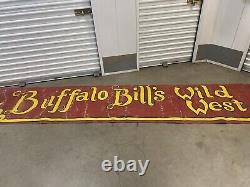

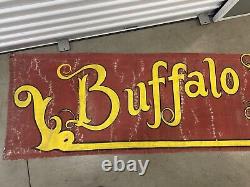


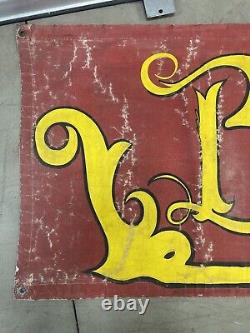

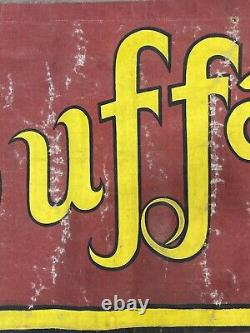
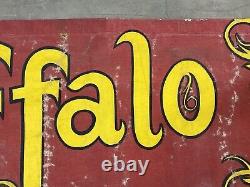
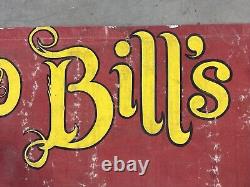
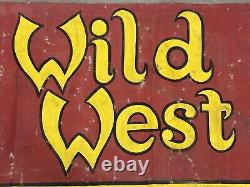
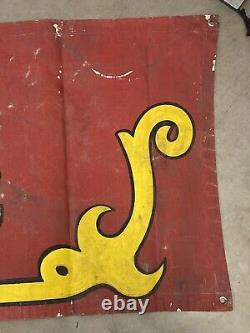




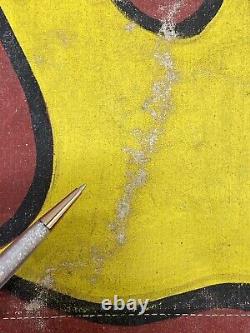
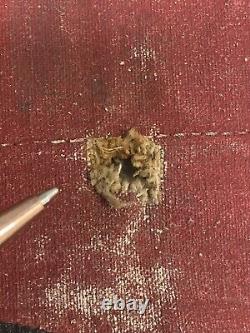
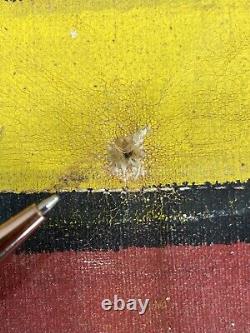






This a culturally important and Historic Antique Old Cowboy BUFFALO BILL Wild West Hand Painted Sideshow Banner, Oil on Canvas, for Buffalo Bill's Wild West show. This piece likely dates to the 1930's - 1940's, a decade or more after the passing of Buffalo Bill Cody (1846 - 1917,) and I suspect that this piece was created and used, with his original name and title, after the rights to the title and show were auctioned off at Denver's Overland Park in Colorado, and Buffalo Bill was subsequently forced to join the Sells Floto Circus, which occurred circa 1913. Perhaps you know more about this item, or where and when it was used? Please message me if you do. This artwork reads: "Buffalo Bill's Wild West" in goldenrod hues, written against a deep red background. This banner was obviously used often and regularly, with heavy folding wear throughout, scuffing, paint loss, paint craquelure, speckles and splashes of obtrusive white paint, small pinholes, soiling, and heavy usage wear to the eyelets of the canvas banner please see photos carefully. Approximately 29 3/4 inches tall x 156 inches wide 13 FEET!!!
Acquired from an eclectic old private collection in Los Angeles County, California. If you like what you see, I encourage you to make an Offer.
Please check out my other listings for more wonderful and unique artworks! "Buffalo Bill" Cody was born just west of the Mississippi River near LeClaire, Iowa, on February 26, 1846. At age 12, he worked for a wagon train headed to Fort Laramie, Wyoming; the next year, he participated in the gold rush to Colorado; and at 15, he reportedly rode for the Pony Express. By the end of his life, he had come to symbolize the American frontier itself. Cody served as a scout for the Union Army's Seventh Kansas Cavalry during the last years of the American Civil War.
On March 6, 1866, he married Louisa Frederici (1843 - 1921) in St. They had four children: Arta Lucille (1866 - 1904), Kit Carson (1870 - 1876), Orra Maude (1872 - 1883), and Irma Louise (1883 - 1918).
In 1867, Cody hunted buffalo for the Kansas Pacific Railroad work crews, earning his moniker "Buffalo Bill" and his reputation as an expert shot. The next year, he was employed by the U. Army as a civilian scout and guide for the Fifth Cavalry.His experience and skills as a plainsman made him an invaluable tracker and fighter. On April 26, 1872, Cody became one of only four civilian scouts to be awarded the U.
Congressional Medal of Honor during the Indian Wars for valor in action. He was later declared ineligible for the medal and stricken from the roll in 1917, but his name was reinstated in 1989 by the Army Board for Correction of Military Records.
Army General Philip Sheridan saw in Cody a combination of charisma and frontier know-how-a natural "public relations windfall" for the Army of the West, which was in need of some good publicity. Under the protection of the Army, visiting dignitaries, such as the Grand Duke Alexis of Russia, took lavish hunting expeditions accompanied by General Sheridan and Brevet Major General George Armstrong Custer with Buffalo Bill as their guide. These excursions were full-scale media events, glamorizing both the military and Cody. During this time, the pulp fiction industry produced inexpensive magazines that romanticized the exploits of the heroes and villains who roamed the plains-including Buffalo Bill, a central figure of many of these inflated truths.
In 1872, dime novel writer Ned Buntline persuaded Cody to portray himself on stage. The "show business bug" hit Cody, and he formed his own "combination" troupe the next year. The group also included James Butler "Wild Bill" Hickok and Texas Jack Omohundro, authentic western characters who gave some credence to the melodrama. On July 17, 1876, just three weeks after Custer and the Seventh Cavalry were defeated at the Battle of Little Big Horn, Cody's regiment intercepted a band of Cheyenne warriors.
When Buffalo Bill, in his stage clothing, killed and scalped a Cheyenne warrior named Yellow Hair (often mistranslated "Yellow Hand"), he reportedly cried out First scalp for Custer! Buffalo Bill the frontiersman had proved that Buffalo Bill the character was no mere actor. The "Great Showman" and Entrepreneur. In 1883, Cody created what would become Buffalo Bill's Wild West, a grand performance that propelled him to fortune and worldwide fame.
The Wild West was staged, in one form or another, for thirty years, playing to enthusiastic crowds throughout the United States and Europe. In Europe, Cody was called "Nature's Nobleman" because he was someone who had grown up on the frontier yet represented all of those best aspects of civilization. Despite his characterization as a figure from the past, Buffalo Bill always looked to the future. As a businessman, he invested in projects that he hoped might bring economic growth to the West. With his earnings, he invested in an Arizona mine, hotels in Sheridan and Cody, Wyoming, stock breeding, ranching, coal and oil development, film making, town building, tourism, and publishing.
In 1899, he established his own newspaper, the. Which is still the main source of news for the town of Cody today. Taking advantage of his celebrity status, Cody was an early advocate of women's suffrage and the fair treatment of American Indians. The most famous American in the world. By the turn of the twentieth century, William F.
Cody was arguably the most famous American in the world. No one symbolized the West for Americans and Europeans better than Buffalo Bill. Every American president from Ulysses S.
Grant to Woodrow Wilson consulted him on matters affecting the American West. He counted among his friends such artists and writers as Frederic Remington and Mark Twain.He was honored by royalty, praised by military leaders, and feted by business tycoons. Cody was America's ideal man: a courtly, chivalrous, self-made fellow who could shoot a gun and charm a crowd. Yet as Annie Oakley put it, He was the simplest of men, as comfortable with cowboys as with kings. A Brief History of William F.
Was born in LeClaire, Iowa, in 1846. While he was still a child, his family moved to Leavenworth, Kansas. Cody left home at the young age of eleven to herd cattle and work as a driver on a wagon train, crossing the Great Plains several times. He went on to fur trapping and gold mining, then joined an early version of the Pony Express in 1860. After the Civil War, Cody scouted for the Army and gained the nickname "Buffalo Bill" as a hunter providing meat for the railroad workers. While he was known locally for his endeavors it was not until he met Ned Buntline, a dime novelist, who transformed his life into a series of larger-than-life stories that he became famous.Buffalo Bill's show business career began on December 17, 1872, in Chicago. He was twenty-six years old. Was a drama created by Ned Buntline, who appeared in it with Cody and another well-known scout, "Texas Jack" Omohundro.
The show was a success, despite some critics commenting on the quality of acting in the show. Other critics noted Cody's manner of charming the audience and the realism he brought to his performance. Actor or not, Buffalo Bill was a showman and audiences were delighted to see him on stage.The following season Cody organized his own troupe, the Buffalo Bill Combination. Included Buffalo Bill, Texas Jack, and Cody's old friend "Wild Bill" Hickok. Wild Bill and Texas Jack eventually left the show, but Cody continued staging a variety of plays until 1882, the year.
Buffalo Bill's Wild West was conceived. Buffalo Bill's Wild West. Was an outdoor spectacle, using hundreds of performers, as well as live buffalo, elk, cattle, and other animals. Cody and the show's management team believed it both educated and entertained visitors. Used real cowboys and cowgirls, recruited from ranches in the West. At first, few people shared Cody's admiration of the cowboys. Most people regarded them as coarse cattle drivers and used the term. By the end of the 19th century, the cow-boy became the much more popular. Thanks in large part to Buffalo Bill's Wild West. The shows demonstrated bronco riding, roping, and other skills that would later become part of rodeos. Was invited to England to participate in the American Exhibition in 1887, the same year as Queen Victoria's Golden Jubilee celebration.Was a hit, visited by nobility, commoners, and by Queen Victoria herself. The show was credited with improving British and American relations. Cody's relationship with American Indians evolved throughout his lifetime.
Before he became a performer himself, Cody was hired as a civilian scout for the Army during the Indian Wars where he fought against tribes. He went on to re-enact many of these battles as part of his. At the same time, he remained sympathetic to the Cheyenne, Lakota, and other tribes, who he believed were entitled to defend their families and their lands. In a time when the Lakota faced decades of broken promises from the American government, suffered greatly from the decimation of the buffalo, and Indian boarding schools attempted to erase their culture through assimilation.
Lakota performers became a centerpiece of the show, but the show itself did little to educate audiences about the trauma American Indians faced from the American government. Towards the end of his life Cody became an advocate for American Indians' civil rights and worked to set up meetings for tribal representatives to meet with presidents and other politicians. In spring of 1859 Buffalo Bill made his first trip to Colorado as part of the Pikes Peak Gold Rush. He passed through the new town of Denver on his way to the gold fields near Black Hawk where he searched for gold for two months, meeting with little success. On his return to Kansas he stopped in Julesburg, Colorado, where he was recruited to ride in an early version of the Pony Express.
Most of his time as a messenger was spent in Kansas, although occasionally he traveled across northeast Colorado. The Pony Express route did not go to Denver but cut north into Nebraska and Wyoming. Cody visited Denver in the 1870s to perform in a local opera house with the Buffalo Bill Combination. He continued to tour through Colorado, performing at the Central City Opera (still in operation) and at another opera house in Georgetown. After Buffalo Bill organized his.
Wild West show, he visited Denver and Colorado many times. Altogether, Buffalo Bill performed 35 times in Colorado between 1886 and 1916. Eventually he got out of that contract but was never able to re-build his Wild West.
In 1917 Buffalo Bill died while visiting his sister's home in Denver. According to his wife Louisa, it was his choice that he be buried on Lookout Mountain overlooking Denver and the plains. Despite the claims of the citizens of Cody, Wyoming, that he really wanted to be buried near Cody, close friends like Goldie Griffith and Johnny Baker, as well as the priest who administered last rites, affirmed that Lookout Mountain was indeed his choice. On June 3, 1917, Buffalo Bill was buried on Lookout Mountain, a site with spectacular views of both the mountains and plains, places where he had spent the happiest times of his life.
Louisa, who married Cody before he became famous, was buried next to her husband in 1921, four years after his death. That same year Johnny Baker, a close friend and unofficial foster son to Cody, opened the Buffalo Bill Memorial Museum. The museum collection moved into the current building next to Pahaska Tepee in 1977. Just as millions of people saw Buffalo Bill in his Wild West shows during his life, millions have visited his grave in the years since 1917.Today the museum and grave is one of the top visitor attractions in Denver and Colorado.

